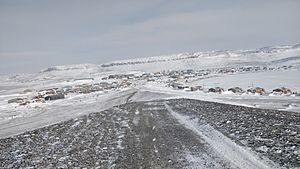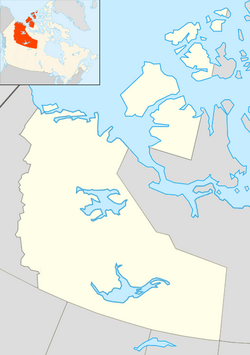Ulukhaktok facts for kids
Quick facts for kids
Ulukhaktok
Ulukhaqtuuq
Uluqsaqtuuq |
|
|---|---|
|
Hamlet
|
|

Looking at Ulukhaktok from the bluffs that give the community its name.
|
|
| Country | Canada |
| Territory | Northwest Territories |
| Government region | Inuvik Region |
| Constituency | Nunakput |
| Census division | Region 1 |
| Land claim | Inuvialuit Settlement Region |
| Settled | 1937 |
| Incorporated (hamlet) | 1 April 1984 |
| Area | |
| • Land | 120.71 km2 (46.61 sq mi) |
| Elevation | 36 m (118 ft) |
| Highest elevation | 36 m (118 ft) |
| Lowest elevation | 0 m (0 ft) |
| Population
(2021)
|
|
| • Total | 408 |
| • Density | 3.4/km2 (9/sq mi) |
| Time zone | UTC−07:00 (MST) |
| • Summer (DST) | UTC−06:00 (MDT) |
| Canadian Postal code |
X0E 0S0
|
| Area code(s) | 867 |
| Telephone exchange | 396 |
| – Living cost (2018) | 192.5 |
| – Food price index (2019) | 179.9 |
| Sources: Department of Municipal and Community Affairs, Prince of Wales Northern Heritage Centre, Canada Flight Supplement 2018 figure based on Edmonton = 100 2019 figure based on Yellowknife = 100 |
|
Ulukhaktok is a small community located on the west coast of Victoria Island in Canada's Northwest Territories. Its name in the local Inuit language, Ulukhaqtuuq, means "the place where ulu parts are found." Before April 1, 2006, it was known as Holman or Holman Island.
For a long time, people in Ulukhaktok earned money by hunting, trapping, and fishing. Today, however, making and selling prints (artworks made using printing techniques) has become the main way people earn a living. The two main languages spoken in Ulukhaktok are Kangiryuarmiutun, which is a dialect of Inuinnaqtun, and English.
This village is also home to something very special: the world's most northerly golf course! Ulukhaktok is part of the Inuvialuit Settlement Region, which is an area where the Inuvialuit people have special land rights.
Contents
History of Ulukhaktok
The first people to settle in the Ulukhaktok area were Natkusiak and his family in 1937. Just two years later, the Hudson's Bay Company moved its trading post here from Walker Bay. A Roman Catholic mission also opened that same year.
The community's first English name, Holman, was chosen to honor J.R. Holman. He was part of an expedition in 1853 that was looking for the famous Arctic explorer, John Franklin. Sometimes, people called it Holman Island, but this is actually the name of a small island nearby.
In 2006, the community decided to change its name to Ulukhaktok. This is the traditional name in the Kangiryuarmiutun language. It means "the place where ulu parts are found" or "a large bluff where we used to collect raw material to make ulus." An ulu is a special knife used by Inuit women. The big bluff (a high, steep cliff) that overlooks Ulukhaktok was where people found the slate and copper needed to make these knives. That's why the people who live there are called Ulukhaktokmiut, meaning "people of Ulukhaktok."
Even though people visited this area for ulu materials and as a camp spot, no one lived there permanently until the Hudson's Bay Company store opened. The Inuit people here traded with groups from far away, showing how connected they were across the Arctic.
People of Ulukhaktok
In 2021, the population of Ulukhaktok was 408 people. Most of the residents, about 96.4%, are Inuvialuit or Inuit. The remaining 3.6% are non-Indigenous. The main languages spoken in the community are Inuinnaqtun (part of the Inuvialuktun language group) and English.
Economy and Culture
Ulukhaktok has a unique economy that blends traditional ways with modern opportunities. The community has learned to protect its wild spaces and important cultural areas. These are places where their ancestors lived and survived in the ice and snow.
A major part of the economy comes from arts and crafts. Local artists are recognized around the world for their work. Sometimes, residents even travel to places like San Francisco or Melbourne to share their art.
The Holman Eskimo Co-op was started in 1961 by the community's residents with help from a Catholic priest named Father Henri Tardy. This Co-op was created to help people earn money by making and selling arts and crafts. It is especially famous for its prints. Artists in Ulukhaktok sell their art through the Ulukhaktok Arts Centre. Famous artists like Mary K. Okheena and Helen Kalvak have created prints for the Co-op. The local school, Helen Kalvak Elihakvik, is named after Helen Kalvak.
In the 1960s and 1970s, the Holman Eskimo Co-operative also made products from sealskin, such as parkas (warm coats), tapestries, and stuffed animals. These sealskin parkas were made to last a very long time.
Today, the Holman Eskimo Co-op is involved in many things, including arts and crafts, retail (selling goods), running a hotel, and even cable television. It also manages the local Canada Post office and fuel delivery, and acts as the local agent for Aklak Air, an airline.
As mentioned before, Ulukhaktok is home to the world's most northern golf course! Every summer, it hosts the "Billy Joss Open Celebrity Golf Tournament." This tournament attracts players from famous sports teams like the Edmonton Oilers and the Edmonton Elks, as well as golfers from other countries. The tournament also includes trips to traditional areas where people fish for Arctic char and Northern Lake trout.
Climate and Weather
Ulukhaktok has a tundra climate. This means it has very short, cool summers and long, very cold winters.
| Climate data for Ulukhaktok (Ulukhaktok/Holman Airport) Climate ID: 2502501; coordinates 70°45′46″N 117°48′22″W / 70.76278°N 117.80611°W; elevation: 36.0 m (118.1 ft); 1981–2010 normals |
|||||||||||||
|---|---|---|---|---|---|---|---|---|---|---|---|---|---|
| Month | Jan | Feb | Mar | Apr | May | Jun | Jul | Aug | Sep | Oct | Nov | Dec | Year |
| Record high humidex | −7.2 | −9.4 | −7.6 | 6.9 | 10.6 | 23.0 | 27.9 | 24.5 | 17.1 | 5.1 | 0.1 | −3.2 | 27.9 |
| Record high °C (°F) | −4.0 (24.8) |
−6.5 (20.3) |
−5.0 (23.0) |
4.5 (40.1) |
11.5 (52.7) |
22.5 (72.5) |
29.0 (84.2) |
23.5 (74.3) |
15.8 (60.4) |
5.9 (42.6) |
1.1 (34.0) |
−3.0 (26.6) |
29.0 (84.2) |
| Mean daily maximum °C (°F) | −24.3 (−11.7) |
−24.9 (−12.8) |
−21.4 (−6.5) |
−12.6 (9.3) |
−3.2 (26.2) |
7.8 (46.0) |
12.8 (55.0) |
9.3 (48.7) |
3.1 (37.6) |
−6.2 (20.8) |
−16.5 (2.3) |
−21.6 (−6.9) |
−8.1 (17.4) |
| Daily mean °C (°F) | −28.0 (−18.4) |
−28.8 (−19.8) |
−25.6 (−14.1) |
−17.0 (1.4) |
−6.6 (20.1) |
4.6 (40.3) |
9.0 (48.2) |
6.4 (43.5) |
0.9 (33.6) |
−8.9 (16.0) |
−19.8 (−3.6) |
−25.2 (−13.4) |
−11.6 (11.1) |
| Mean daily minimum °C (°F) | −31.8 (−25.2) |
−32.6 (−26.7) |
−29.8 (−21.6) |
−21.4 (−6.5) |
−10.0 (14.0) |
1.4 (34.5) |
5.2 (41.4) |
3.4 (38.1) |
−1.3 (29.7) |
−11.4 (11.5) |
−23.1 (−9.6) |
−28.6 (−19.5) |
−15.0 (5.0) |
| Record low °C (°F) | −47.5 (−53.5) |
−49.0 (−56.2) |
−45.0 (−49.0) |
−42.1 (−43.8) |
−26.5 (−15.7) |
−12.5 (9.5) |
−3.5 (25.7) |
−5.5 (22.1) |
−15.5 (4.1) |
−36.8 (−34.2) |
−37.5 (−35.5) |
−42.8 (−45.0) |
−49.0 (−56.2) |
| Record low wind chill | −59.8 | −59.2 | −61.9 | −45.6 | −31.0 | −18.3 | −6.8 | −11.1 | −21.9 | −44.7 | −51.3 | −51.2 | −61.9 |
| Average precipitation mm (inches) | 8.4 (0.33) |
7.5 (0.30) |
7.3 (0.29) |
5.3 (0.21) |
7.4 (0.29) |
8.0 (0.31) |
22.4 (0.88) |
32.2 (1.27) |
19.8 (0.78) |
17.1 (0.67) |
11.5 (0.45) |
8.5 (0.33) |
155.3 (6.11) |
| Average rainfall mm (inches) | 0.0 (0.0) |
0.0 (0.0) |
0.0 (0.0) |
0.0 (0.0) |
1.1 (0.04) |
6.9 (0.27) |
22.2 (0.87) |
30.2 (1.19) |
13.2 (0.52) |
0.6 (0.02) |
0.0 (0.0) |
0.0 (0.0) |
74.2 (2.92) |
| Average snowfall cm (inches) | 8.5 (3.3) |
7.5 (3.0) |
7.5 (3.0) |
5.3 (2.1) |
6.4 (2.5) |
1.2 (0.5) |
0.2 (0.1) |
2.0 (0.8) |
6.6 (2.6) |
16.9 (6.7) |
12.3 (4.8) |
8.9 (3.5) |
83.3 (32.8) |
| Average precipitation days (≥ 0.2 mm) | 5.3 | 5.2 | 4.9 | 3.9 | 4.8 | 4.7 | 7.8 | 11.0 | 9.3 | 9.5 | 7.3 | 5.3 | 78.9 |
| Average rainy days (≥ 0.2 mm) | 0.0 | 0.0 | 0.0 | 0.0 | 0.6 | 3.9 | 7.8 | 10.5 | 6.3 | 0.4 | 0.0 | 0.0 | 29.4 |
| Average snowy days (≥ 0.2 cm) | 5.3 | 5.2 | 5.0 | 3.9 | 4.4 | 1.0 | 0.2 | 0.8 | 3.5 | 9.4 | 7.4 | 5.4 | 51.5 |
| Source: Environment and Climate Change Canada | |||||||||||||
Notable People
- Mary K. Okheena (born 1957), a well-known graphic artist.
Images for kids






